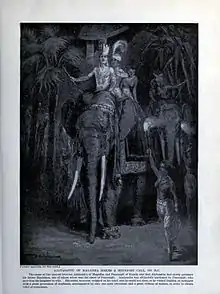Magadha-Vajji war
The Magadha-Vajji War was a conflict between the Haryanka dynasty of Magadha and the neighbouring Vajji confederacy which was led by the Licchavis. The conflict is remembered in both Buddhist and Jain traditions. The conflict ended in defeat for the Vajji confederacy and the Magadhans annexing their territory.[1][2]

| Magadha-Vajji War | |||||||||
|---|---|---|---|---|---|---|---|---|---|
| |||||||||
| Belligerents | |||||||||
| Haryanka dynasty of Magadh | Vajji confederacy led by the Licchavis | ||||||||
| Commanders and leaders | |||||||||
| Ajatashatru | Chetaka | ||||||||
Conflict
There are differing accounts between the Jain and Buddhist traditions as to how the war played out although both sides agree that the Magahdans were victorious and ended up conquering the region.[1]
Buddhist tradition
According to the Buddhist tradition, there was a diamond mine near a village on the river Ganges. There was an agreement between Ajatashatru and the Licchavis of Vajji that they would have an equal share. However one day, Ajatashatru failed to collect his own share and the entire load were taken by the Vajjians. This happened on multiple occasions, and at last, Ajatashatru lost his patience and thought, "it is almost impossible to fight against the whole confederacy of Vaishali. I must uproot these powerful Vajjis and exterminate them". He sent his chief minister Vassakara to Buddha to ask him the purpose of Vaishali being invincible, to which Buddha gave seven reasons which included Vajjis being punctual to the meetings, their disciplined behaviour, their respect for elders, respect for women, they do not marry their daughters forcefully, they give spiritual protection to the Arhats, and the main reason was the Chaityas (altar) inside the town.[1][3]
Ajatashatru sent his chief minister Vassakara to infiltrate the Vajji confederacy and within three years he had managed to split the Vajjis and also demolished the altars in Vaishali. Ajatashatru used a scythed chariot with swinging mace and blades on both the sides and attacked the town and conquered it with little resistance.[1]
Jain tradition
The Jain tradition has been pieced together from multiple sources and confirms many of the Buddhist accounts but also differs in many ways. Queen Padmavati, the wife of Ajatashatru while sitting on her balcony saw Halla and Vihalla kumaras with their wives sitting on an elephant and one of the wives was wearing the 18 fold divine necklace.[1]
She went to her husband Ajatashatru who requested both brothers to give the elephant and the necklace to him, which both brothers denied saying that these gifts were given by their father. Ajatashatru sent the request thrice but got the same reply all three times. In response he sent his men to arrest them however the two brothers escaped to their maternal grandfather Chetaka who was the king of Vajji and the leader of the Licchavi clan. Ajatashatru sent notice thrice to Chetaka to surrender them but was denied by Chetaka.[4] This was enough for Ajatashatru. He called his half-brothers, Kalakumaras (10 kalakumaras, those born to King Bimbisara and 10 Kali Queens Kali, Sukali, Mahakali, etc.) to merge their army with his. As he could not possibly hope to defeat the Vajjians without their help. On the other hand, Chetaka invited his own allies; 9 Mallas, 9 Lichhavis and 18 kings of Kasi-Kosala to fight Ajatashatru.[2]
As the war began, King Chetaka, who was a devout follower of Mahavira, had a vow to not shoot more than one arrow per day in a war. It was known to all that Chetaka's aim was perfect and his arrows were infallible. His first arrow killed one commander of Ajatashatru's. On the following nine days, the rest of the nine commanders were killed by Chetaka.
According to legend, as Ajatashatru was moving towards defeat he practised penance for three days and offered prayers to Indra to help him achieve victory. In the following battle, the Vajjians were defeated and the Licchavis were abandoned by the other confederate tribes so they took shelter inside the city walls of Vaishali and closed the main gate. The walls around Vaishali were so strong that Ajatashatru was unable to break through them. Eventually, they succeeded in breaching the walls and conquering Vaishali and the surrounding region.[1]
Role of the Buddha
According to the account that is given in the Mahāparinibbāṇa Sutta in the Buddhist tradition, the Buddha advised Vassakāra of the seven conditions of welfare which would ensure the prosperity of Vajji. Vassakara inferred from this the way to defeat the Vajjis. There is a debate as to whether the Buddha did this intentionally.[2][5]
See also
References
- A. L Basham (1951). "Ajātasattu's War with the Licchavis". Proceedings of the Indian History Congress. 14: 37–41. JSTOR 44303932.
- Pandita, Ven (2011). "The Buddha and the Māgadha-Vajjī War". Journal of Buddhist Ethics. 18: 126–144. Retrieved 2 August 2020.
- James A. Benn; Lori Meeks; James Robson (10 September 2009). Buddhist Monasticism in East Asia: Places of Practice. Routledge. pp. 20–. ISBN 978-1-134-00991-6.
- Upinder Singh (2008). A History of Ancient and Early Medieval India: From the Stone Age to the 12th Century. Pearson Education India. pp. 260–263. ISBN 978-81-317-1677-9.
- Chakrabarti, Dilip (1995). "Buddhist sites across South Asia as influenced by political and economic forces". World Archaeology. 27 (2): 185–202. doi:10.1080/00438243.1995.9980303.
